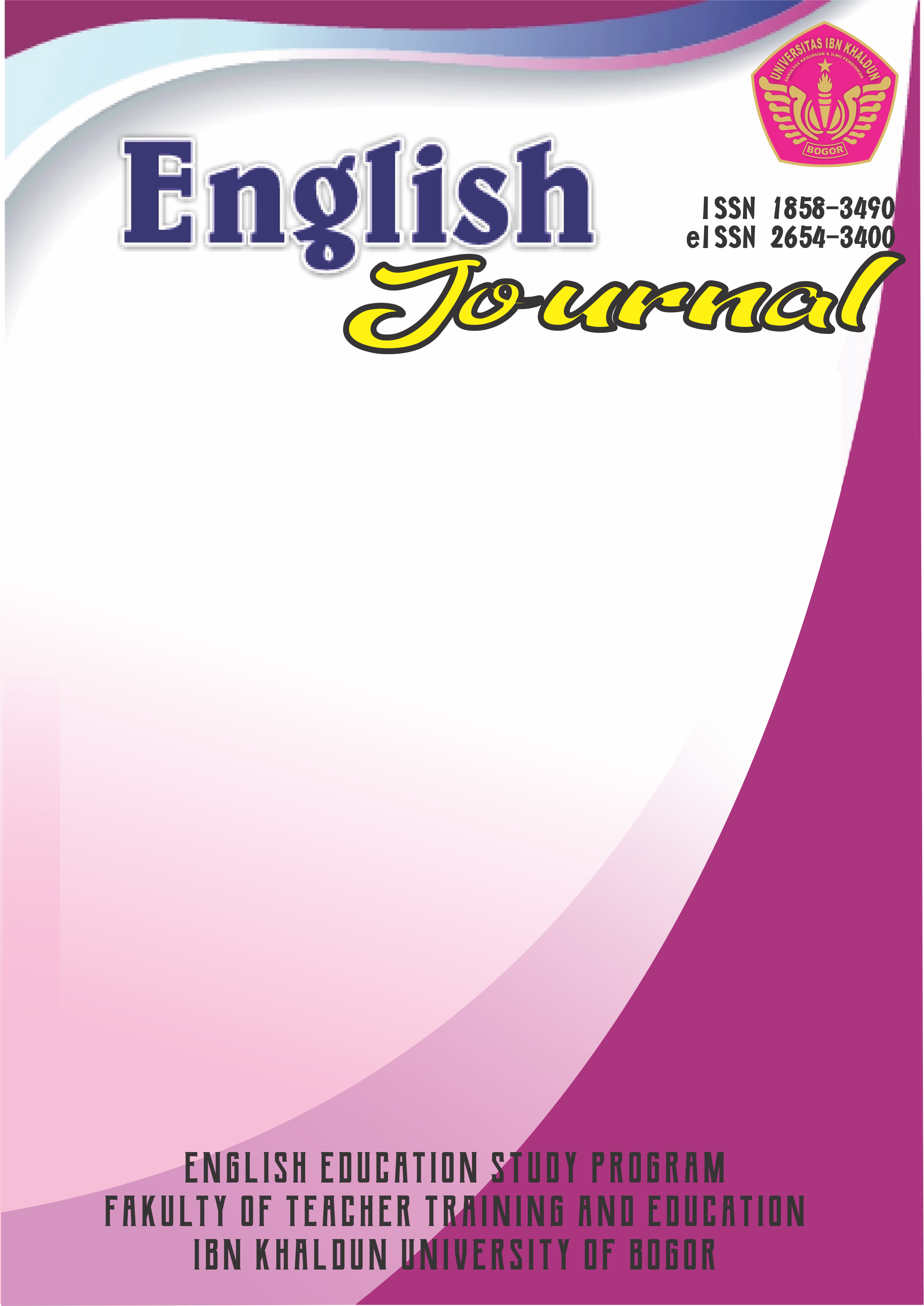THE IMPLEMENTATION OF JUST A MINUTE (JAM) TECHNIQUE TO SCAFFOLD STUDENTS' SPEAKING FLUENCY: A CASE STUDY
DOI:
https://doi.org/10.32832/english.v14i1.3784Abstract
Fluency happens to be the main obstacle for EFL learners in mastering speaking. There are many ways to scaffold students' speaking fluency; one of them is Just a Minute (JAM). JAM is an impromptu speech activity where the speaker is supposed to express their ideas on the given topic, within the duration of a minute, without hesitation and repetition. The purposes of this research are to describe the implementation of JAM, the impact of using JAM, and the students' perception towards the use of JAM. Case study method was used in conducting the research. The qualitative data was obtained from observation, rubric, questionnaire, and interview. The participants of the research are nine students of XII Hotel Accommodation in SMKN 3 Bogor. The results of the research show that JAM can be well-implemented in English formal classroom, JAM has given positive impact in scaffolding students' speaking fluency, and JAM has gained students' positive perception towards its use. This study suggests the English teachers to try adapting JAM as a mean to help their students scaffold the speaking fluency.
References
Abrar, M., et al. (2018). "If our English isn't a language, what is it?” Indonesian EFL Student Teachers' Challenges Speaking English. The Qualitative Report, 23(1), 129-145. Retrieved from https://nsuworks.nova.edu/tqr/vol23/iss1/9.
Al Hosni, S. (2014). Speaking difficulties encountered by young EFL learners. International Journal on Studies in English Language and Literature (IJSELL), 2(6), 22-30. Retrieved from: https://www.researchgate.net/.
Asrida, D. (2016). Communicative activities of teaching speaking for the students. Ta'dib, 17(1), 60-65. Retrieved from: http://ecampus.iainbatusangkar.ac.id/.
Creswell, John W. (2012). Educational research: planning, conducting and evaluating quantitative and qualitative research. Boston: Pearson.
Darwis, R. (2016). Students' Perceptions towards the Use of Podcast in Learning English: a Case Study of the Second Grade Students at One High School in Bandung. Journal of English and Education, 4(2), 80-100. Retrieved from: https://pdfs.semanticscholar.org/.
Derakhshan, A., et al. (2016). Developing EFL learner's speaking ability, accuracy and fluency. English Language and Literature Studies, 6(2), 177-186. Retrieved from: https://www.researchgate.net/.
Dixon, G. (2014). ‘Just a minute' 5 steps to making fluency fun. Retrieved from: https://busyteacher.org/20564-5-steps-to-making-fluency-fun-just-a-minute.html.
Education, P. (2005). World view levels 1-4: Video/DVD/Speaking Rubric for Fluency Activities Copyright by Pearson Education, In. Boston: Pearson.
Ferraro, M. (2015). Investigation of cooperative learning and collaborative testing in grades 4-8. Ontario Institute for Studies in Education of the University of Toronto. Retrieved from: https://tspace.library.utoronto.ca/handle/1807/68792.
Gayathri, S. (2016). Just a Minute (or JAM): A Joyous Communication Enhancement Game. International Journal of Communication and Media Studies, 6(1). Retrieved from: https://papers.ssrn.com/sol3/papers.cfm?abstract_id=2724379.
Harmer, J. (2007). The practice of English language teaching. Essex. England: Pearson Education.
Hunter, J. (2011). ‘Small Talk': developing fluency, accuracy, and complexity in speaking. ELT journal, 66(1), 30-41. Retrieved from: https://doi.org/10.1093/elt/ccq093.
Husnawati. (2017). Students' Speaking Performance: Some Challenging Factors. Banda Aceh: Universitas Islam Negeri Ar-Raniry Darussalam.
Iswara, A. A., et al. (2012). Improving Students' Speaking Fluency through the Implementation of Trivia-Based Activity in University Students. Retrieved from: https://eprints.uns.ac.id/13756/.
Kayi, H. (2012). Teaching speaking: Activities to promote speaking in a second language. Довейшие научные доÑтижениÑ, 12(2012). Retrieved from: http://iteslj.org/Techniques/Kayi-TeachingSpeaking.html.
Kianiparsa, P., & Vali, S. (2010). The Effect of grammar learning on speaking ability of EFL learners. ELT Weekly, 2(53), 7-15. Retrieved from: http://eltweekly.com/.
Leong, L. M., & Ahmadi, S. M. (2017). An analysis of factors influencing learners' English speaking skill. International Journal of Research in English Education, 2(1), 34-41. Retrieved from: http://ijreeonline.com/.
Lewis, A. (2001). The issue of perception: some educational implications. Educare, 30(1), 272-288.
Munn, P., & Drever, E. (2004). Using questionnaires in small-scale research: A beginner's guide. Glasgow, Scotland: Scottish Council for Research in Education.
Nagel, D. (2012). Fluency in a language – what does that mean exactly?. Retrieved from: https://www.mezzoguild.com/being-fluent-in-your-target-language/.
Prasutiyo, A.R. (2014). Improving The Eighth Grade Students‘ Reading Skill Through SQ3R Technique in SMPN 1 Jogonalan in The Academic Year of 2013/2014. A Thesis. Retrieved from: http://eprints.uny.ac.id/.
Elfira Dwi, Rosanti & Jaelani, Alan. (2016). The Use of Lexical Hedges in Spoken Language by Female and Male Students. English Journal, Vol. 16, No.1, pp. 29-39.
Soy, Susan K. (2002). The case study as a research method. Retrieved from: https://www.ischool.utexas.edu/~ssoy/usesusers/l391d1b.htm.
Thornbury, S. (2005). How to teach speaking. Longman.
Wilson, K., & Devereux, L. (2014). Scaffolding theory: High challenge, high support in Academic Language and Learning (ALL) contexts. Journal of Academic Language and Learning, 8(3), A91-A100.
Zainal, Z. (2007). Case study as a research method. Jurnal Kemanusiaan, 5(1). Retrieved from: https://jurnalkemanusiaan.utm.my/index.php/kemanusiaan/article/view/165.
Zyoud, M. (2016). Theoretical Perspective on How to Develop Speaking Skill among University Students. Pune Research Scholar; An International Multidisciplinary Journal Vol. 2 Issue, 1, 1-10. Retrieved from: https://www.researchgate.net/.

















1.png)




